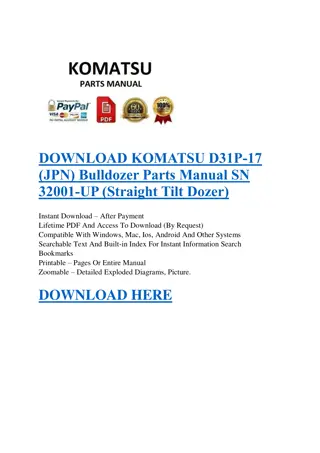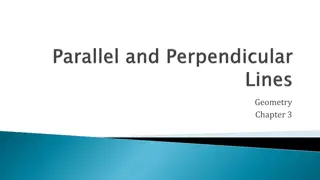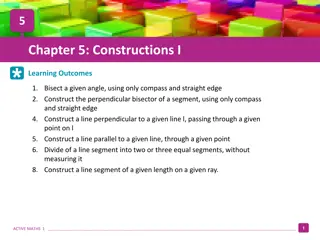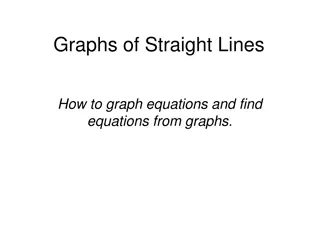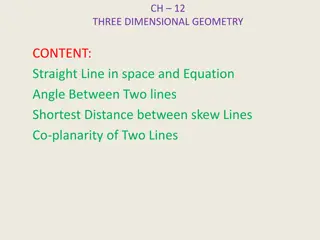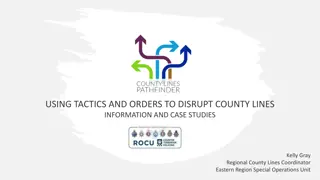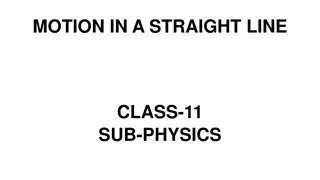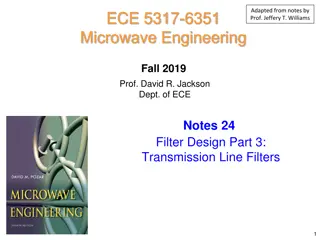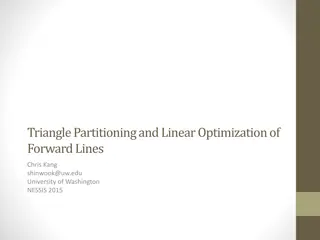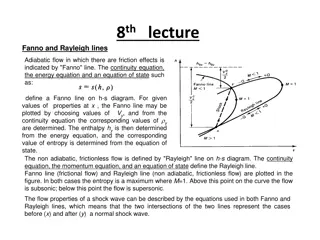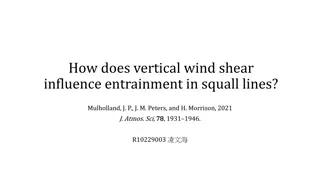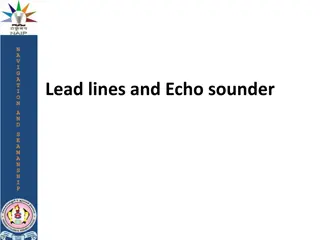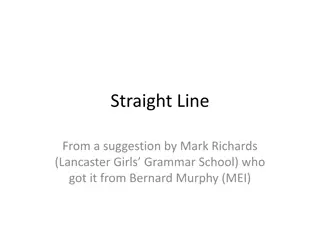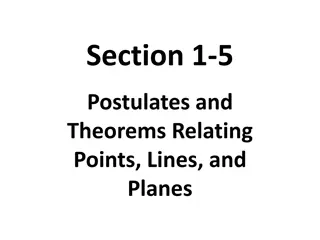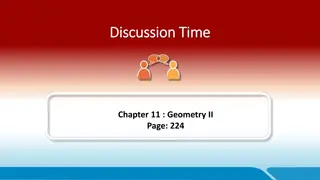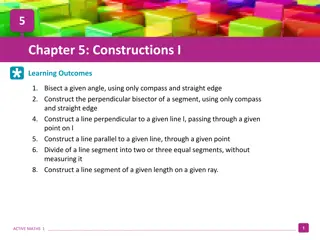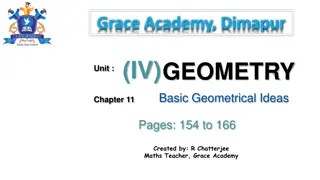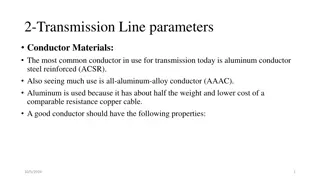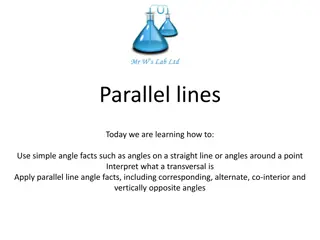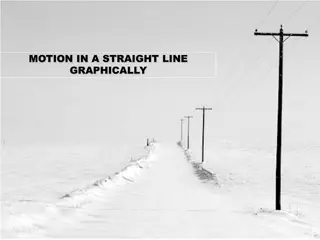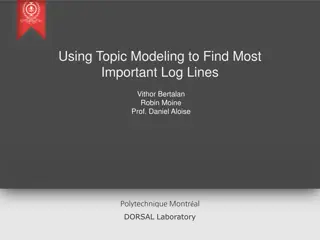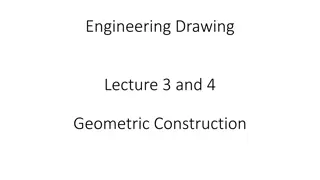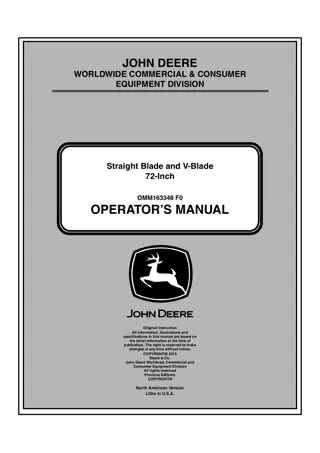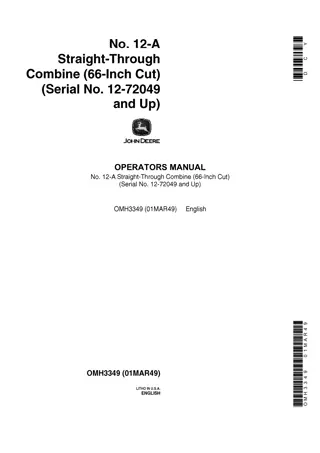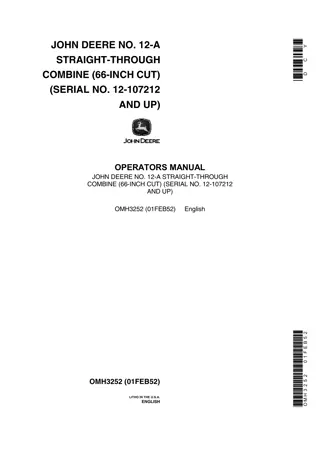Motion Along a Straight Line
Exploring kinematics in the context of motion along a straight line, this chapter delves into parameters like displacement, velocity, speed, and acceleration. Kinematics is distinguished from dynamics, focusing on how objects move without delving into why. Displacement, a key concept, is discussed a
7 views • 60 slides
Memory Units in Computing
Memory units are essential components in computing devices that store binary information in words, allowing for fast and efficient data retrieval. They consist of storage cells, circuits, and address selection lines for communication. Random Access Memory (RAM) enables quick access to data, while Re
6 views • 15 slides
KOMATSU D31P-17 (JPN) Bulldozer Parts Manual SN 32001-UP Straight Tilt Dozer
DOWNLOAD KOMATSU D31P-17 (JPN) Bulldozer Parts Manual SN 32001-UP (Straight Tilt Dozer)
2 views • 1 slides
Comprehensive Overview of Geometry Chapter 3 Concepts
Dive into the fundamentals of lines, planes, parallelism, and angles in Geometry Chapter 3. Explore topics such as identifying lines and planes, understanding parallel and perpendicular lines, and recognizing angle relationships formed by transversals. Discover the properties of parallel lines, tran
2 views • 42 slides
Geometric Constructions using Compass and Straight Edge
Learn how to bisect angles, construct perpendicular bisectors, draw perpendicular and parallel lines, divide line segments equally, and more using only a compass and straight edge in geometry. Follow step-by-step instructions with illustrations to master fundamental constructions.
3 views • 11 slides
Skew Lines and Planes in 3D Geometry
Explore the concepts of skew lines, parallel lines, perpendicular lines, and planes in 3D geometry through real-life examples and equations. Learn about the shortest distance between skew lines and solve problems related to their applications.
1 views • 46 slides
Graphs of Straight Lines and Equations
Learn how to graph equations and find equations from graphs of straight lines. Explore tables of values, plotting points on a coordinate plane, drawing lines through points, and identifying relationships between graphs and algebraic expressions. Discover the gradient-intercept form of a straight lin
0 views • 14 slides
Geometry Learning - Lines of Symmetry Activities
Explore various activities focused on lines of symmetry in shapes. Engage in identifying symmetrical shapes, finding lines of symmetry through folding, sorting shapes based on symmetrical properties, drawing lines of symmetry, and reasoning about symmetrical shapes. Enhance your understanding of sym
1 views • 16 slides
Three-Dimensional Geometry: Direction Cosines and Angles
Understanding direction cosines and angles in three-dimensional geometry is crucial for determining the orientation of lines in space. By calculating direction cosines, we can find the angles a line makes with the positive directions of the X, Y, and Z axes. This knowledge helps in various geometric
2 views • 18 slides
Electric Field Lines and Charges
Electric field lines provide a visual representation of the electric field around charges. They show the direction of the electric field and help understand the intensity of the field at different points. Field lines never cross each other and the tangent at any point on a line gives the field direc
4 views • 40 slides
Parallel and Perpendicular Lines
Students will learn to identify and write equations of parallel and perpendicular lines by understanding the relationship between slopes. Parallel lines have the same slope, while perpendicular lines intersect to form right angles. Through examples and explanations, students will gain the skills to
2 views • 12 slides
Using Tactics and Orders to Disrupt County Lines: Case Studies and Strategies
Exploring the approach of using tactics and orders to disrupt county lines, this content outlines the Drug Dealing Telecommunications Restriction Order (DDTRO) process and its impact on drug supply chains. Case studies like the successful DDTRO conducted by the North West Regional Organised Crime Un
1 views • 21 slides
Motion in a Straight Line: Class 11 Physics
Explore the principles and concepts related to motion in a straight line as covered in Class 11 Physics. Dive into topics such as displacement, velocity, acceleration, and more through a series of informative slides. Enhance your understanding of this fundamental aspect of physics with visual aids a
0 views • 19 slides
Microwave Filter Design Using Transmission Lines
Explore the design of microwave filters using transmission lines, starting with lumped-element designs and transitioning to transmission line approximations. Learn how to realize series inductors and shunt capacitors using narrow and wide sections of microstrip lines. Discover techniques such as Ric
0 views • 28 slides
Overview of Damping Ring and Transfer Lines for FCC-ee Pre-Injector Complex
The Damping Ring and Transfer Lines play a crucial role in the FCC-ee Pre-Injector Complex, aiming to damp the emittance of both beams and operate the damping ring at higher energy levels. Coordinated by experts like C. Milardi and A. De Santis, the project includes designs for the Damping Ring, Tra
0 views • 29 slides
Stock Valuation and Voting Rights in Corporation Governance
Features of common and preferred stocks, voting rights in straight and cumulative voting, and the cost to secure a seat on a board of directors in a corporation with cumulative voting are discussed. The differences between straight voting and cumulative voting, the impact of staggering elections in
1 views • 32 slides
Triangle Partitioning and Linear Optimization in Hockey Line Analysis
In this presentation, the speaker discusses the use of triangle partitioning and linear optimization techniques to analyze hockey team lines. The goal is to find chemistry between players, allocate ice time effectively, and match up against opposing lines for a better chance of winning games. Tradit
0 views • 16 slides
Buffon's Needle Experiment: Probability Estimation through Sticks Crossing Lines
Buffon's Needle Experiment involves dropping sticks on parallel lines to estimate a mathematical constant through the frequency of the sticks crossing the lines. The experiment explores the theoretical introduction, probability calculations, equipment setup, and hypotheses related to accuracy and pr
0 views • 26 slides
Angle Relationships with Parallel Lines
Explore the concept of angle relationships created by intersecting lines and transversals. Learn about linear pairs, congruent angles, supplementary angles, alternate interior and exterior angles, corresponding angles, and more. Engage in activities, quizzes, and worksheet assignments to deepen your
0 views • 9 slides
Warm Lines: A Vital Support System Beyond Crisis Intervention
In the realm of mental health support, warm lines serve as invaluable resources beyond crisis intervention hotlines. Originating in the late 1950s, these lines cater to individuals facing non-crisis challenges such as depression, loneliness, and relationship issues. Project Return Peer Support Netwo
0 views • 27 slides
Fanno and Rayleigh Lines in Adiabatic Flow
Fanno and Rayleigh lines on the h-s diagram help in analyzing adiabatic flow with friction effects. The Fanno line represents frictional flow, while the Rayleigh line signifies non-adiabatic, frictionless flow. These lines aid in plotting flow properties and understanding phenomena like shock waves
0 views • 6 slides
Influence of Vertical Wind Shear on Entrainment in Squall Lines
The strength and direction of low-level (LL) and upper-level (UL) wind shear influence the properties of squall line updrafts, with stronger shear environments fostering wider updrafts that are less susceptible to entrainment-driven dilution. The relative influences of LL and UL shear on this relati
0 views • 40 slides
Lead Lines and Echo Sounders for Depth Measurement
Dive into the world of lead lines and echo sounders for depth measurement. Discover the ancient navigational instrument, the construction of lead lines, and the markings used for different depths. Learn about the traditional use of lead lines by fishermen and the importance of these tools in shallow
0 views • 23 slides
Solving Geometric Problems with Straight Lines
Explore a unique geometric problem involving straight lines and triangles. Follow the step-by-step process to find the areas of red and blue triangles, determine the numerical area of the intersection, and derive the equation of the line using coordinate geometry. Illustrative images aid in understa
0 views • 21 slides
Geometric Postulates and Theorems Relating Points, Lines, and Planes
This section introduces the postulates and theorems related to points, lines, and planes in geometry. It covers basic assumptions, postulates about lines and planes, and theorems about intersections. The concept of "exactly one" and "one and only one" is emphasized, highlighting the unique relations
1 views • 10 slides
Geometry II - Understanding Lines and Arcs in a Circle
This content discusses concepts related to geometry, focusing on lines and arcs within a circle. It explores the properties of lines AB and APB, measures of angles AOB and APB, as well as the shapes formed within the circle. The discussion provides a clear understanding of the terminology and geomet
1 views • 4 slides
Geometric Constructions: Mastering Compass and Straight Edge Techniques
Explore the art of geometric constructions using only a compass and straight edge. Learn to bisect angles, construct perpendicular bisectors, draw lines perpendicular to given lines, create parallel lines, divide line segments equally, and more. Equip yourself with the necessary skills and technique
0 views • 11 slides
Basic Geometrical Ideas in Geometry
Basic Geometrical Ideas in Geometry cover the fundamental concepts of points, lines, and planes. Points are described as having location but no size, lines are infinite sets of points, and collinearity is discussed. The importance of straightness in lines is assumed but not defined. Symbols and nota
0 views • 45 slides
Types of Conductors in Transmission Lines
Aluminum conductors, such as AAC, AAAC, ACSR, and ACAR, are commonly used in transmission lines due to their high conductivity, tensile strength, light weight, and resistance to corrosion. AAC is known for its good conductivity but limited strength, while AAAC offers better mechanical strength and c
0 views • 17 slides
Parallel Lines and Angle Relationships
Learning about parallel lines involves using angle facts like those on a straight line or around a point. By interpreting what a transversal is, you can apply angle relationships such as corresponding, alternate, co-interior, and vertically opposite angles. Practice finding unknown angles and identi
0 views • 20 slides
Motion in a Straight Line Graphically
Explore how to interpret distance-time and velocity-time graphs, derive equations of motion with constant acceleration, and analyze examples of motion scenarios through graphical representations in a straight line. Learn to sketch graphs, calculate distances, and understand relationships between spe
0 views • 10 slides
Mapping QTL and Selection of Soybean Lines with High Essential Amino Acids
Soybean (Glycine max L.) plays a crucial role as a crop in North Carolina, especially for its essential amino acids content critical for human and animal nutrition. This study aims to identify quantitative trait loci (QTL) for essential amino acids in soybean seeds using a genetic map from the Forre
0 views • 4 slides
Enhancing Customer Relationship Management through Mobile Working and Straight Through Processing
Delve into the realm of CRM, mobile working, and straight-through processing with insights from Louise Hodgson, CRM Strategy Manager, and Dave Roberts, Service Development Manager. Learn about the transformation from siloed teams and disparate processes to an effective CRM organization leveraging te
0 views • 17 slides
Enhancing Speed Control with COSBI Lines: A Study by Jaco van der Spuy
Explore the effectiveness of controlling speed through illusion lines known as COSBI Lines, as investigated by Jaco van der Spuy in a recent study. The presentation delves into the purpose, introduction, literature study, case study, results, and questions surrounding this innovative method. Discove
0 views • 27 slides
Utilizing Topic Modeling for Identifying Critical Log Lines in Research
By employing Topic Modeling, Vithor Bertalan, Robin Moine, and Prof. Daniel Aloise from Polytechnique Montréal's DORSAL Laboratory aim to extract essential log lines from a log parsing research. The process involves building a log parser, identifying important log lines and symptoms, and establishi
0 views • 18 slides
Geometric Construction in Engineering Drawing: Lecture Highlights
Geometric construction involves creating primitive geometric forms like points, lines, and planes to define objects in space. The lecture covers the basics of 2D geometric primitives, such as points, lines, circles, and arcs. It explains the significance of points and lines in technical drawings and
0 views • 18 slides
John Deere 72-Inch Straight Blade and V-Blade Operator’s Manual Instant Download (Publication No.OMM163348)
John Deere 72-Inch Straight Blade and V-Blade Operator\u2019s Manual Instant Download (Publication No.OMM163348)
0 views • 10 slides
John Deere NO.12-A Straight-Through Combine (66-Inch Cut) Operator’s Manual Instant Download (Pin.12-72049 and up) (Publication No.OMH3349)
John Deere NO.12-A Straight-Through Combine (66-Inch Cut) Operator\u2019s Manual Instant Download (Pin.12-72049 and up) (Publication No.OMH3349)
0 views • 20 slides
John Deere NO.12-A Straight-Through Combine (66-Inch Cut) Operator’s Manual Instant Download (Pin.12-107212 and up) (Publication No.OMH3252)
John Deere NO.12-A Straight-Through Combine (66-Inch Cut) Operator\u2019s Manual Instant Download (Pin.12-107212 and up) (Publication No.OMH3252)
0 views • 21 slides
John Deere NO.12-A Straight-Through Combine (66-Inch Cut) Operator’s Manual Instant Download (PIN12-65519 and up) (Publication No.OMH31148)
John Deere NO.12-A Straight-Through Combine (66-Inch Cut) Operator\u2019s Manual Instant Download (PIN12-65519 and up) (Publication No.OMH31148)
0 views • 21 slides


